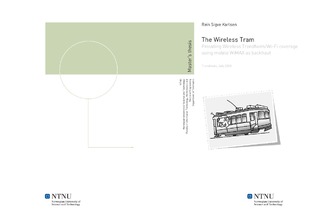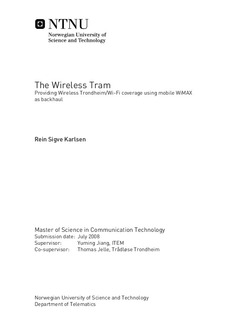| dc.contributor.advisor | Jiang, Yuming | nb_NO |
| dc.contributor.advisor | Jelle, Thomas | nb_NO |
| dc.contributor.author | Karlsen, Rein Sigve | nb_NO |
| dc.date.accessioned | 2014-12-19T14:12:23Z | |
| dc.date.available | 2014-12-19T14:12:23Z | |
| dc.date.created | 2010-09-03 | nb_NO |
| dc.date.issued | 2008 | nb_NO |
| dc.identifier | 347712 | nb_NO |
| dc.identifier | ntnudaim:4100 | nb_NO |
| dc.identifier.uri | http://hdl.handle.net/11250/261762 | |
| dc.description.abstract | In spring 2008, a pre-mobile WiMAX network is installed in Trondheim. Its purpose is to cover the tram line and provide wireless backhaul to a Wi-Fi hotspot inside the tram, thus providing Internet access to travelling passengers. Testing is carried out in order to investigate if WiMAX can be used in such scenario. Based on radio propagation modelling, two sectors are initially set up to cover the entire tram line. The WiMAX system operates in the 2.6 GHz band with a bandwidth of 5 MHz. Testing reveals that reception along the first half of the tram line, covered by the first sector, is mostly according to the Okumura-Hata models for open and sub-urban areas. Adequate signal quality for a high grade of service (-80 dBm) is achieved up to 1.5 km from the base station. The second half of the tram line, covered by the second sector, is mostly according to the Okumura-Hata models for sub-urban and urban areas. The coverage provided by the second site is only enough to provide adequate signal quality half a kilometre from the base station. It is concluded that two sectors are not adequate to cover the entire tram line from start to end. The impact of 2nd order diversity is also investigated with respect to signal quality and throughput. Separation in space and by polarisation are both tested. A noticeable increase in average throughput of 50% is measured when using diversity with separation in space. Separation by polarisation yields an average increase of 14% only. Improvements in coverage when using diversity is very small, measured to a few hundred meters. It is noted that the throughput achieved along the tram line varies with the speed of the tram. When standing still, maximum TCP throughput in the downlink is measured to just above 6 Mbps, which is only 70% of the theoretical maximum of 9 Mbps when using an UL/DL ratio of 50/50. While in motion, the TCP throughput seldom rises above 1 Mbps. It is expected that the low throughput in motion is caused by a combination of Doppler effects and the use of an omni-directional antenna on the tram. | nb_NO |
| dc.language | eng | nb_NO |
| dc.publisher | Institutt for telematikk | nb_NO |
| dc.subject | ntnudaim | no_NO |
| dc.subject | SIE7 kommunikasjonsteknologi | no_NO |
| dc.subject | Telematikk | no_NO |
| dc.title | The Wireless Tram: Providing Wireless Trondheim/Wi-Fi coverage using mobile WiMAX as backhaul | nb_NO |
| dc.type | Master thesis | nb_NO |
| dc.source.pagenumber | 196 | nb_NO |
| dc.contributor.department | Norges teknisk-naturvitenskapelige universitet, Fakultet for informasjonsteknologi, matematikk og elektroteknikk, Institutt for telematikk | nb_NO |

